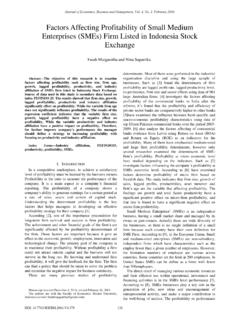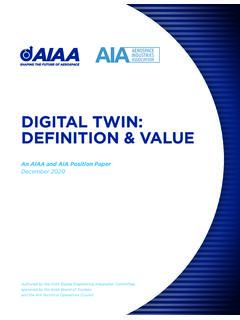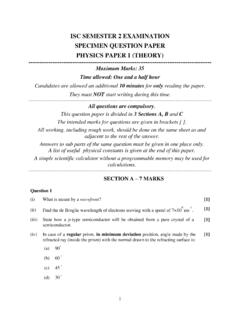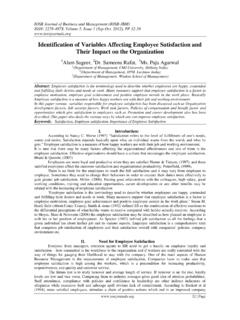Transcription of Taylor’s “Scientific Management Principles”: Contemporary ...
1 Abstract Scientific Management trend , which claims that there is only one best way to deal with every issue and directs its efforts to finding this way and applying it on production process, underpins today s Management science. We still witness the effects of Taylor s insights and theories, who is the pioneer of this trend, on modern Management understanding. It is observed that traditional Management understanding which was criticised by Taylor is completely ignored in the personnel selection process. Also, it is noticed that a more advanced level has been attained by using the scientific Management methods which were pointed out by Taylor in the process of personnel selection. The purpose of this study is to evaluate the harmony of Taylor s insights and techniques in modern Management and portray the contributions of Taylor on human resources Management in the personnel selection process.
2 I. INTRODUCTION Even though it existed with the emergence of the first person, Management concept which is defined as carrying out the work through people in general, it is thanks to Taylor that it was called as science . Taylor is a pioneering model due to his initiations for creating the science of production studies. Moreover, Taylor s Principles of Scientific Management titled masterpiece is still a fundamental resource for the ones who do research in this field. It is based on induction and adopts a pragmatic and empiricist method, and its there has to be a best way to do a certain job principle has advanced among the others. This principle has inevitably reached to the time and motion study, the equation of employees with machines and finally automation and robot science [1].
3 Although Taylor made great contributions to the Management as a science, he received harsh criticisms as well. The focus of the criticisms he received lies in the fact that he put the human factor into the background. However, we still see that Taylor s many insights are still valid in today s modern Management trend. Although his ideas have been harshly criticised, the fact that they are still valid displays the importance of the subject. The idea to select the personnel by means of scientific methods, which is the content of our study, was suggested by Taylor first. Previously, traditional methods had been used to employ the personnel. In the traditional method, an employee was evaluated whether s/he was appropriate for the job or not after s/he was employed.
4 In this case, both the employer and employee suffered from it. Thanks to the use of Taylor s scientific Management techniques, it could be said that this damage is subsidized. Within this scope, the current study consists of three parts. In the first part, Taylor s life is elaborated since his characteristics are important in the theory he developed. Afterwards, his most significant work titled Scientific Management Techniques is mentioned. In the second part, the selection of the personnel, which is one of the basic functions of human resources Management , in Scientific Management Techniques is discussed. In the third section, the state of Taylor s insights, techniques and contributions to today s modern Management perception in terms of human resources Management within the scope of personnel selection are discussed.
5 II. TAYLOR AND SCIENTIFIC Management PRINCIPLES Born into a wealthy family in the US in 1856, Frederick Winslow Taylor wanted to study law, but, had to quit his university education due to certain health problems. Starting as a machinist apprentice in 1874, Taylor noticed that production was limited by the employees and found the opportunity to closely observe the lack of compliance between the employees and employers during his four-year apprenticeship. Taylor started as an employee in Midvale Steel Company in 1878 and having started by noticing the lack of scientific education, he graduated from Stevens Institute Technology as a mechanical engineer in 1883. Later on, he worked in various positions in Midvale and he became a chief engineer in 1884.
6 He had the opportunity to make some observations and experiments in the meantime. He left from Midvale in 1890 and worked as a general director in Manufacturing Investment for three years, Taylor decided to work as a consultant engineer due to the accounting knowledge and engineering past he acquired during his last position . He made great contributions to the development of the companies by applying innovative ideas he developed for some big firms among his customers to increase the industrial productivity [2]. Mentioned as the first intellectual of industrial engineering besides being a mechanical engineer, Taylor did some important studies to increase the industrial productivity. Taylor joined American Mechanical Engineers association in 1885 and presented two articles here.
7 The name of the first article was Piece Rate . In this article, Taylor suggested changing wage system in order to motivate the ones who work harder. The second article titled Shop- Management . He focused on Management philosophy, emphasized the necessity of high wage and low cost per unit, and therefore Taylor s Scientific Management Principles : Contemporary Issues in Personnel Selection Period Hakan Turan Journal of Economics, Business and Management , Vol. 3, No. 11, November 20151102 DOI: Terms Frederick Winslow Taylor,scientific Management approach, human resources Management , personnel received September 22, 2014; revised November 24, Turan is with the Hitit University,FEAS, Political Science and Public Administration, orum, Turkey(e-mail: the manager-workman/workwoman collaboration in the selection and training of the personnel in compliance with scientific methods was pointed at in this article.)
8 The audience failed to understand what Taylor emphasized by assuming that money was taken into consideration more than systematic managerial work [3]. Taylor collected his ideas in the article titled The Principles of Scientific Management published in 1911. Taylor s work titled The Principles of Scientific Management was adopted in the USA first, and all the managers across the globe later. In this work, he claimed that Management is not only made up of theory, but his fund of knowledge took its source from the applications within the factory and continuously evolved. Scientific method should be discussed as a mental revolution rather than a means of productivity which came into fashion at that time.
9 The employers and managers who would realize this revolution should have increased the income by collaborating with each other instead of sharing surplus income [4]. Taylor accepts the collaboration between the manager and workmen/workwomen as an essential principle in the implementation of Taylorism. If the collaboration between the manager and personnel working the organization is not attained, other methods and techniques are of little use. Although scientific method seems to adopt the increase in production, it endeavours to solve the problems between the managers and workmen/ workwomen [5]. Drucker emphasized the importance of Scientific Management Principles as follows: It is the productivity revolution which removes the discrepancies of capitalism and prevents proletarian class from growing poor, and the person who started this revolution is Taylor [6].
10 In fact, this period coincides with the end of nineteenth century and the first half of the twentieth century. This period witnessed the individualism, liberalism, capitalism and similar movements in North America and Europe. Also, this period is the one on which the production, based on the application of these movements, and productivity came into prominence. In other words, it is an era when the behaviours of human were disregarded to a certain extent [7]. Rational Economic Man Theory which is often mentioned in classic economy and grounded on the opinion of people s acting according to their interests, became the modal on which scientific Management philosophy is based. Taylor commenced to work by moving from the Adam smith s assumption that people run after their interests.











